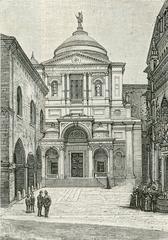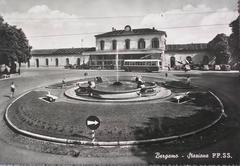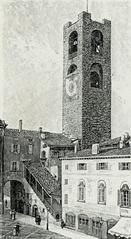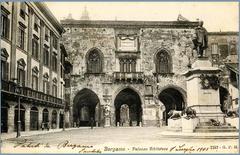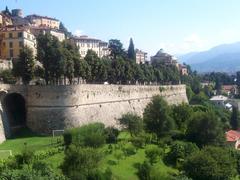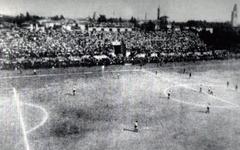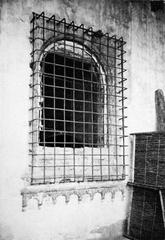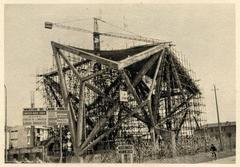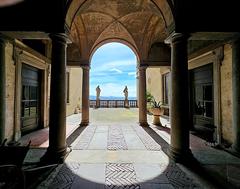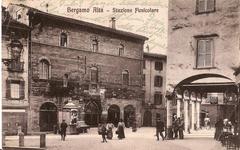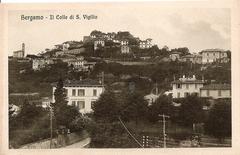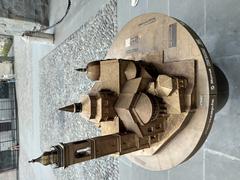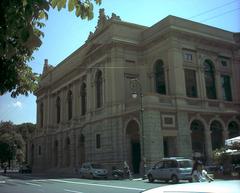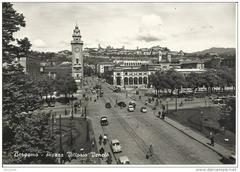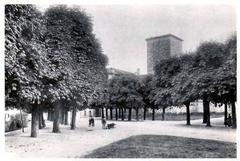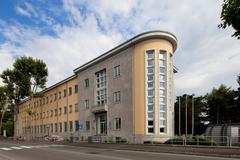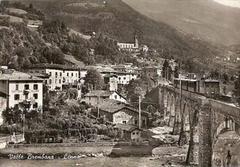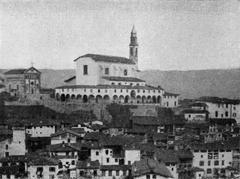
Sant’Agostino Bergamo: Visiting Hours, Tickets, and Historical Significance Guide
Date: 04/07/2025
Introduction
Sant’Agostino in Bergamo stands as a testament to the city’s layered history, blending medieval religious tradition with Renaissance art and contemporary academic life. Founded by the Eremitani friars in the 13th century, this Gothic monument has evolved from a spiritual and cultural hub into a vibrant part of the University of Bergamo’s campus. Its strategic position at the eastern gate of Città Alta, near the UNESCO-listed Venetian Walls, makes it a key landmark for both heritage and urban identity (Italyscapes; Lombardia Beni Culturali).
Visitors can admire Sant’Agostino’s distinctive Gothic architecture, explore its cloisters, and discover 14th-century frescoes by local masters. The complex hosts exhibitions, concerts, and academic events, reflecting its ongoing role as a bridge between Bergamo’s past and present (Visit Bergamo; In Lombardia; Bergamo News). This guide provides detailed information on Sant’Agostino’s history, architecture, visiting hours, ticketing, guided tours, accessibility, and practical tips to help you plan an enriching visit.
For up-to-date information, refer to the University of Bergamo’s official page and the Visit Bergamo tourism website.
Historical Overview
Medieval Foundation
Construction of Sant’Agostino began in 1290 on the site of an older church. The Eremitani friars established the complex as both a religious and educational center. The new church was consecrated in 1347, and by the early 14th century, it was already a significant place for worship and learning (Italyscapes; Lombardia Beni Culturali).
Renaissance Restoration
After a period of decline, the site was revived by the Observant Friars in the 15th century. They restored the monastery, built the Chiostro Minore, and later added the Chiostro Maggiore. During this era, several local families funded the construction of side chapels in exchange for burial rights. The church was spared demolition during the construction of the Venetian Walls, unlike many other Bergamo churches (Italyscapes).
Napoleonic and Modern Transformations
With the arrival of Napoleon in 1797, the church was deconsecrated and used as military barracks. Over the following centuries, the complex served as a warehouse, prison, and later as an academic institution. Restoration efforts in the 19th and 20th centuries, culminating in a major renovation in 2014–2015, paved the way for its integration into the University of Bergamo campus (Visit Bergamo; In Lombardia).
Architectural and Artistic Highlights
Exterior
Sant’Agostino’s facade exemplifies Italian Gothic design, with squared sandstone blocks, pilasters, a central rose window, and a marble statue of Saint Augustine. The round-arched portal reveals Nordic Gothic influences that are unusual for Lombardy (Italyscapes; Visit Bergamo).
Interior and Frescoes
The church features a single nave flanked by 15 chapels, each originally sponsored by noble families. The ceiling comprises over 1,600 tempera-painted tiles, and the walls are adorned with some of the most important 14th-century fresco cycles in Bergamo. Notable works include a fragmentary “Last Supper,” a “Madonna and Child with Saint Anne,” and episodes from the lives of saints, attributed to leading local artists of the era (Lombardia Beni Culturali).
The Cloisters
- Chiostro Minore: Dating to the 15th century and recently restored, it showcases elegant loggias and frescoes, and serves as a venue for academic and cultural events (In Lombardia).
- Chiostro Maggiore: Added in the 16th century, reflecting the monastery’s Renaissance expansion (Lombardia Beni Culturali).
Both cloisters are surrounded by green spaces, enhancing the contemplative atmosphere.
Adaptive Reuse
Sant’Agostino’s integration into the University of Bergamo is a model of heritage preservation. The former church now serves as the Aula Magna, retaining its historic features while supporting contemporary academic activities (Visit Bergamo).
Visitor Information
Visiting Hours
- General Campus and Cloisters: Monday to Friday, 9:00 AM – 6:00 PM. Some spaces are open on weekends during special events or exhibitions.
- Exhibitions/Events: Hours may vary; always check the University of Bergamo or Comune di Bergamo in advance.
Tickets
- General Admission: Free for most areas, as the site functions as an academic campus and public cultural venue.
- Special Events/Guided Tours: May require a ticket (€5–10 typical for guided tours). Book through the tourism office, Itinerari Bergamo, or local guides (Across Bergamo).
Accessibility
- Wheelchair Access: The main entrance and cloisters are accessible, but some historic areas may be challenging due to uneven floors or steps. Contact the university or event organizers in advance for details.
- Restrooms: Available in adjacent university buildings and public areas nearby.
Getting There
- Address: Via Porta Dipinta 63, Città Alta, Bergamo.
- Public Transport: Funicular from Bergamo Bassa to Città Alta; local buses.
- Parking: Closest lot is Parcheggio Piazza Mercato del Fieno, but spaces are limited.
Facilities
- Seating and Shelter: Provided during events; interior spaces are comfortable year-round.
- Nearby Services: Numerous cafés, restaurants, and shops are within a short walk.
Guided Tours and Special Experiences
- Guided Tours: Available in multiple languages and focus on history, art, and architecture. Advance booking is recommended, especially for English tours (Across Bergamo).
- Thematic Activities: Art installations, concerts, and workshops are regularly scheduled. Multilingual student-led tours and interactive exhibits are highlights during festivals and open days.
Seasonal and Restoration Updates
2025 Restoration Projects
- Parco Sant’Agostino: Closed for hydrogeological safety works and restoration until late 2025, affecting access to some outdoor areas and summer events (Bergamo Tomorrow).
- Venetian Walls and Porta Sant’Agostino: Ongoing works may alter access routes; check updates before visiting.
Event Programming
- “Estivo di Sant’Agostino” Festival: Suspended in 2025 due to park restoration; alternative venues host summer events.
- Bergamo Next Level Festival: Takes place within the cloisters and Aula Magna, featuring lectures, video mapping, and exhibitions (Bergamo News).
Practical Tips
- Combine Visits: Pair Sant’Agostino with the Venetian Walls, Piazza Vecchia, and local museums for a full day of exploration.
- Photography: Allowed in most areas; avoid flash and tripods to protect artworks.
- Quiet Respect: As it is an active university campus, maintain a respectful demeanor, especially during academic sessions.
- Weather: Interiors stay cool in summer and may be chilly in winter—dress accordingly.
Frequently Asked Questions (FAQ)
Q: What are Sant’Agostino’s visiting hours?
A: Generally Monday to Friday, 9:00 AM – 6:00 PM, with variations during events and exhibitions.
Q: Is there an entrance fee?
A: Admission is free for general access; some events or guided tours require tickets.
Q: Is Sant’Agostino accessible for people with disabilities?
A: The main areas are accessible, though some historic sections may be challenging.
Q: Are guided tours available?
A: Yes, book through the tourism office or local guides.
Q: Can I visit during park restoration?
A: Outdoor areas may be closed, but indoor spaces and events continue.
Visuals and Interactive Content
Include images of the facade, frescoes, cloisters, and surrounding parks. Embed an interactive map of Città Alta and links to virtual tours. Optimize image alt tags (e.g., “Sant’Agostino Bergamo facade,” “Sant’Agostino cloisters,” “Bergamo historical sites”) for SEO.
Annual and Recurring Cultural Events
Sant’Agostino is a mainstay of Bergamo’s cultural calendar. The summer “estivo” festival, though suspended in 2025 due to restoration, usually features open-air concerts, cinema, and food stalls (Bergamo Tomorrow). The “Bergamo Next Level” festival highlights innovation at the intersection of history and sustainability, with immersive exhibits and student-curated tours (Bergamo News).
Recent restorations, such as the reopening of the Biblioteca Umanistica and discovery of new frescoes, are regularly celebrated through dedicated exhibitions and talks (Bergamo News).
Summary and Recommendations
Sant’Agostino combines centuries of history, art, and academic vitality. Despite temporary restoration closures in 2025, the site remains accessible, with free general admission and a dynamic range of guided tours and events. Its integration with the University of Bergamo ensures ongoing preservation and engagement, making it a highlight of any Bergamo itinerary.
For the best experience, check official resources for the latest hours and events, book guided tours in advance, and plan your visit during periods of cultural programming. Download the Audiala app for audio guides and follow relevant social channels for updates.
Sources
- Sant’Agostino Bergamo: Visiting Hours, Tickets, and Historical Highlights, Italyscapes
- Sant’Agostino Bergamo Historical and Architectural Details, Lombardia Beni Culturali
- Ex Monastery of Sant’Agostino and Fara, Visit Bergamo
- Chiostro di Sant’Agostino, In Lombardia
- Dialogues on the Future at Sant’Agostino: Bergamo Next Level 2025, Bergamo News
- Inauguration of the Restored Humanities Library, Bergamo News
- Sant’Agostino Visiting Hours and Tickets, Comune di Bergamo
- Tourist Information for Bergamo, Itinerari Bergamo
- Bergamo Tourism Office, Turismo Bergamo
- Bergamo Cultural Events and Restoration Updates, Bergamo Tomorrow













